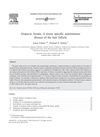TLDR Patients with severe active alopecia areata have lower CD200 expression and an imbalance in their immune system.
The study investigated the Th1/Th2 peripheral blood balance and CD200 expression in 50 patients with active severe alopecia areata (SAA), 50 with stable SAA, and 50 healthy controls. It found that active SAA patients had significantly lower CD200 expression on CD3+ T lymphocytes and CD19+ B lymphocytes, as well as lower CD200 mRNA levels. Additionally, these patients exhibited higher levels of IFN-γ and lower levels of IL-10, indicating a Th1/Th2 imbalance. The study concluded that decreased CD200 expression and Th1/Th2 imbalance might be associated with the pathogenesis of SAA, suggesting potential targets for therapeutic intervention.
550 citations
,
December 2005 in “The Journal of clinical investigation/The journal of clinical investigation” Researchers successfully isolated and identified key markers of stem cell-enriched human hair follicle bulge cells.
 185 citations
,
August 2005 in “Autoimmunity Reviews”
185 citations
,
August 2005 in “Autoimmunity Reviews” Alopecia areata is an autoimmune condition causing hair loss due to the immune system attacking hair follicles, often influenced by genetics and stress.
 14 citations
,
November 2020 in “International Journal of Molecular Sciences”
14 citations
,
November 2020 in “International Journal of Molecular Sciences” Advanced therapies like gene, cell, and tissue engineering show promise for hair regrowth in alopecia, but their safety and effectiveness need more verification.
15 citations
,
December 2018 in “International journal of environmental research and public health/International journal of environmental research and public health” EGCG may help treat alopecia areata by blocking certain immune responses and reducing specific harmful immune cells.
1 citations
,
January 2025 in “Genes & Diseases” Understanding T cells and signaling pathways can lead to better treatments for hair loss.
 October 2023 in “bioRxiv (Cold Spring Harbor Laboratory)”
October 2023 in “bioRxiv (Cold Spring Harbor Laboratory)” A protein called EGFR protects hair follicle stem cells, and when it's disrupted, hair follicles can be damaged, but blocking certain pathways can restore hair growth.
55 citations
,
April 2015 in “BMC medicine” Stem Cell Educator therapy helps regrow hair and improve life quality in alopecia areata patients.


